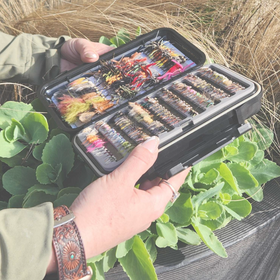Often over looked by fly fisher is the damsel fly, a seasonal staple in many waters for foraging trout. Although it doesn’t garner the attention of mayfly, caddis, and salmonfly hatches, and vacations aren’t planned around its emergence; it is still an integral part of many a trout’s diet. Perhaps, even more importantly, fishing these imitations can often produce large fish and quick, hard strikes.
 - The damselfly nymph is a very important food source in lakes and slower rivers (photo: www.troutnut.com)
- The damselfly nymph is a very important food source in lakes and slower rivers (photo: www.troutnut.com)It is not that fly fishers don’t notice damsel flies. In fact, they are very hard to miss, at least the adult ones are. Confusing damsels with dragonflies is a common enough mistake, but in actuality everyone can easily tell the difference. For one thing, damsels are smaller, more colorful, and more common. Their wings also have the ability to lie flat. The adult damsel's body can range from blue, to tan, to olive. Males are usually more colorful.
The damselfly nymphs are long (usually and inch to inch and a half), and are easily identified by their bead like eyes, and the three broad tail like gills. Nymphs are voracious carnivores, and live predominantly around weed beds in slow water. Common thought has them only of importance in lakes, but their numbers, size and heartiness make them important in many rivers as well.
 - Damselfly nymphs can vary in body shapes and colors (photo: www.troutnut.com)
- Damselfly nymphs can vary in body shapes and colors (photo: www.troutnut.com)
The nymphs are climbers, spending most of their time on vegetation filling their vast appetite. They live about a year, going through up to 12 molts. Emerging is actually done on land. This requires them to swim to shore, to climb out on vegetation or debris. By this time they have well developed wing pads. Their emergence on can be en masse, or can occur sporadically over a period of months. A large emergence can mean vast numbers of swimming nymphs eagerly pursued by foraging trout. This type of emergence occurs mostly in lakes where the nymphs are not separated by faster currents of water. This can be the premier time to fish at many locales.
 - The Carey Special is a great pattern that imitates damsel nymphs and small dragonfly nymphs
- The Carey Special is a great pattern that imitates damsel nymphs and small dragonfly nymphs
When fishing the damsel fly nymph, it is important to impart the same movement of your fly. Getting the right waggle is the name of the game. Using a slow, hand-twist retrieve with pauses should entice a greedy strike or two. The naturals are slow swimmers when compared to trout, and often pause motionless during their migration to adulthood.
Still fishing is also effective, with just an occasional tug. Vary the thrust, and duration until you find the perfect combination that attracts the fish. The idea is to imitate an insect at rest.
 - The Adult Damselfly is an iconic insect found all across the US
- The Adult Damselfly is an iconic insect found all across the US
There are other times when their presence makes them a logical choice for the dry fly fisher. No trout skulking in the weed beds would actively refuse an adult placed there for the taking. If fishing ponds for bass or bluegill, then a well placed damsel can cause an eruption.
Setting your calendar to this insect is difficult at best. While they are prolific, they also are spread out. In general, emergence takes place in spring and in late summer. To add to their importance, the adults actually live for up to three months. Unlike mayflies, they feed during their adult phase, and the same female can lay eggs multiple times. The nymphs are of most importance during the spring emergence and again during the summer emergence. But also when they hatch in the fall, indeed fishing the nymphs into early winter can be effective as their appetites grow. The warmer your climate the longer their activity continues. But the hearty damsel is never far from water’s edge, and shouldn’t be far from your fly box either.




